

AS Unit 1. More from the 1905-1906 Russian Underground Press. A few months back I posted images from 1905-1906 Russian revolutionary periodicals that I found at Yale University’s digital library.
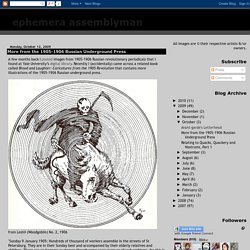
Recently I (accidentally) came across a related book called Blood and Laughter: Caricatures from the 1905 Revolution that contains more illustrations of the 1905-1906 Russian underground press. from Leshii (Woodgoblin) No. 2, 1906 "Sunday 9 January 1905: Hundreds of thousand of workers assemble in the streets of St Petersburg. They are in their Sunday best and accompanied by their elderly relatives and children. There are no banners or slogans though some carry icons or church emblems, for this is to be a peaceful demonstration led by an Orthodox priest, Father Gapon. For two cold hours they stand waiting in the snow for Tsar Nicholas to appear and receive their petition. Bloody Sunday killed superstition, the old faith in a just Tsar, and unleashed a tumultuous rage among the masses.
Russia had a rich history of satirical journalism. "In the State Duma. Content Curation Tools Supermap by Robin Good. The Russian Revolution (2006) The 1905 Russian Revolution was a wave of mass political and social unrest that spread through vast areas of the Russian Empire.
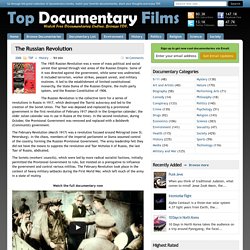
Some of it was directed against the government, while some was undirected. It included terrorism, worker strikes, peasant unrest, and military mutinies. Russian revolution. World History Teachers Blog: Russian Revolution Documentary Clips. Thousands of Australian students are taught that robots led the Russian Revolution. Kinja is in read-only mode.
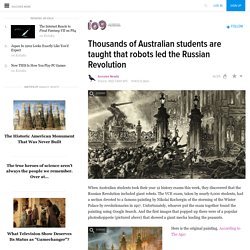
We are working to restore service. Holy crap you're right! It's not a revolution, it's an invasion! Flagged Shit, it wasn't 1999! I'm not quite sure of the legalities, but sometime around the time that Robotech went to air in North America, using footage borrowed from Macross, FASA also published their Battletech miniatures wargame, and the related Mechwarrior RPG. FASA licensed the design.. but from the original production company. I think FASA took the right idea when after all that they went "No more licensed designs".
History vs. Vladimir Lenin - Alex Gendler. Bloody Sunday, Russian Krovavoye Voskresenye , (January 9, 1905), massacre in St.
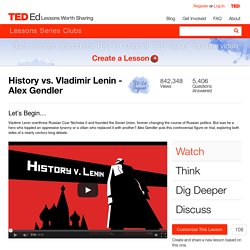
Petersburg, Russia, of peaceful demonstrators marking the beginning of the violent phase of the Russian Revolution of 1905. At the end of the 19th century, industrial workers in Russia had begun to organize; police agents, eager to prevent the Labour Movement from being dominated by revolutionary influences, formed legal labour unions and encouraged the workers to concentrate their energies on making economic gains and to disregard broader social and political problems.The 1905 Russian Revolution was sparked off by a peaceful protest held on January 22nd. This protest may well have been the turning point in the relationship the czar, Nicholas II, enjoyed with his people. Led by a Russian Orthodox priest, Father Gapon, 150,000 people took to the cold and snow covered streets of St Petersburg to protest about their lifestyle.
The Russian Revolution. The webserver at Alpha History tells us you’re using an adblocking tool, plug-in or browser extension on your computer or network.

We understand that many people don’t like web-based advertising. Ads on websites can often be irrelevant, distracting and ‘in your face’. Without ads, however, our website would not exist – or it would not be free. Ads are how we fund the creation and delivery of our content. We love providing free textbook-quality content and resources to people like you. What is Marxism? A Bird's-Eye View < DIALECTICAL MARXISM: The Writings of Bertell Ollman. What is Marxism?
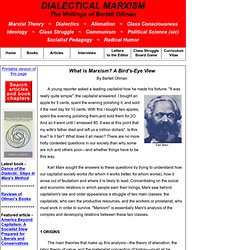
A Bird's-Eye View By Bertell Ollman A young reporter asked a leading capitalist how he made his fortune. "It was really quite simple", the capitalist answered. I bought an apple for 5 cents, spent the evening polishing it, and sold it the next day for 10 cents. Karl Marx sought the answers to these questions by trying to understand how our capitalist society works (for whom it works better, for whom worse), how it arose out of feudalism and where it is likely to lead. BOLSHEVIK CONSOLIDATION OF POWER. RUSSIAN REVOLUTION - FLOW CHARTS. Russia 1917-1941. In this module you will learn: • FIVE strengths and SEVEN weaknesses of the Tsar’s Government in 1913.
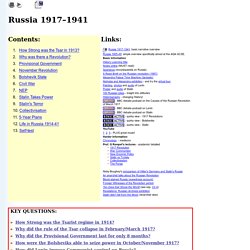
Open Websites. Internet History Sourcebooks. The Bolshevik Seizure of Power. The Russian Revolution through the Prism of Propaganda. Why study the Russian Revolution?
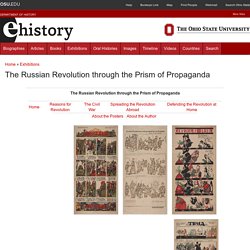
The Russian Revolution is one of the most important events of the twentieth century. In February 1917, Tsar Nicholas II abdicated, and a representative Provisional Government succeeded the autocracy. In October, the Bolsheviks, led by Vladimir Lenin, overthrew the Provisional Government. They would go on to establish the world's first socialist state and attempt to spread socialist revolution around the world. In so doing, they issued a strong ideological challenge to the capitalist world. For much of the post-World War II period, the majority of people on the planet lived in a state that identified itself as either capitalist or socialist.
Why study propaganda posters?